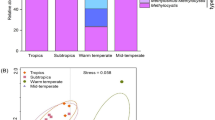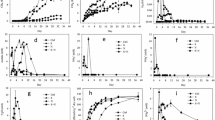Abstract
Methanotrophs are crucial in regulating methane emission from rice field systems. Type II methanotrophs in particular are often observed in high abundance in paddy soil. Some cultivated species of Methylocystis are able to grow on acetate in the absence of methane. We hypothesize that the dominant type II methanotrophs in paddy soil might facultatively utilize acetate for growth, which we evaluate in the present study. The measurement of methane oxidation rates showed that the methanotrophic activity in paddy soil was inhibited by the addition of acetate compared to the continuous supplementation of methane, but the paddy soil maintained the methane oxidation capacity and recovered following methane supplementation. Terminal restriction fragment length polymorphism analysis (T-RFLP) combined with cloning and sequencing of pmoA genes showed that Methylocystis was enriched after incubation with added acetate, while the type I methanotrophs Methylocaldum/Methylococcus and Methylobacter were enriched by methane supplementation. A comparison of pmoA sequences obtained in this study with those in the public database indicated that they were globally widespread in paddy soils or in associated with rice roots. Furthermore, we performed stable isotope probing (SIP) of pmoA messenger RNA (mRNA) to investigate the assimilation of 13C-acetate by paddy soil methanotrophs. RNA-SIP revealed that Methylocystis-related methanotrophs which shared the same genotype of the above enriched species were significantly labelled. It indicates that these methanotrophs actively assimilated the labelled acetate in paddy soil. Altogether, these results suggested that uncultivated Methylocystis species are facultative methanotrophs utilizing acetate as a secondary carbon source in paddy soil.





Similar content being viewed by others
References
Op den Camp HJM, Islam T, Stott MB, Harhangi HR, Hynes A, Schouten S, Jetten MSM, Birkeland NK, Pol A, Dunfield PF (2009) Environmental, genomic and taxonomic perspectives on methanotrophic Verrucomicrobia. Environ Microbiol Rep 1:293–306
Sharp CE, Smirnova AV, Graham JM, Stott MB, Khadka R, Moore TR, Grasby SE, Strack M, Dunfield PF (2014) Distribution and diversity of Verrucomicrobia methanotrophs in geothermal and acidic environments. Environ Microbiol 16:1867–1878
Conrad R (2007) Microbial ecology of methanogens and methanotrophs. Adv Agron 96:1–63
Horz HP, Yimga MT, Liesack W (2001) Detection of methanotroph diversity on roots of submerged rice plants by molecular retrieval of pmoA, mmoX, mxaF, and 16S rRNA and ribosomal DNA, including pmoA-based terminal restriction fragment length polymorphism profiling. Appl Environ Microbiol 67:4177–4185
Lüke C, Frenzel P (2011) Potential of pmoA amplicon pyrosequencing for methanotroph diversity studies. Appl Environ Microbiol 77:6305–6309
Ma K, Conrad R, Lu YH (2013) Dry/wet cycles change the activity and population dynamics of methanotrophs in rice field soil. Appl Environ Microbiol 79:4932–4939
Hanson RS, Hanson TE (1996) Methanotrophic bacteria. Microbiol Rev 60:439–471
Semrau JD, DiSpirito AA, Yoon S (2010) Methanotrophs and copper. FEMS Microbiol Rev 34:496–531
Macalady JL, McMillan AMS, Dickens AF, Tyler SC, Scow KM (2002) Population dynamics of type I and II methanotrophic bacteria in rice soils. Environ Microbiol 4:148–157
Wu LQ, Ma K, Lu YH (2009) Rice roots select for type I methanotrophs in rice field soil. Syst Appl Microbiol 32:421–428
Ma K, Lu YH (2011) Regulation of microbial methane production and oxidation by intermittent drainage in rice field soil. FEMS Microbiol Ecol 75:446–456
Qiu QF, Noll M, Abraham WR, Lu YH, Conrad R (2008) Applying stable isotope probing of phospholipid fatty acids and rRNA in a Chinese rice field to study activity and composition of the methanotrophic bacterial communities in situ. ISME J 2:602–614
Shrestha M, Abraham WR, Shrestha PM, Noll M, Conrad R (2008) Activity and composition of methanotrophic bacterial communities in planted rice soil studied by flux measurements, analyses of pmoA gene and stable isotope probing of phospholipid fatty acids. Environ Microbiol 10:400–412
Reim A, Lueke C, Krause S, Pratscher J, Frenzel P (2012) One millimetre makes the difference: high-resolution analysis of methane-oxidizing bacteria and their specific activity at the oxic-anoxic interface in a flooded paddy soil. ISME J 6:2128–2139
Semrau JD, DiSpirito AA, Vuilleumier S (2011) Facultative methanotrophy: false leads, true results, and suggestions for future research. FEMS Microbiol Lett 323:1–12
Dedysh SN, Knief C, Dunfield PF (2005) Methylocella species are facultatively methanotrophic. J Bacteriol 187:4665–4670
Dunfield PF, Belova SE, Vorob’ev AV, Cornish SL, Dedysh SN (2010) Methylocapsa aurea sp. nov., a facultative methanotroph possessing a particulate methane monooxygenase, and emended description of the genus Methylocapsa. Int J Syst Evol Microbiol 60:2659–2664
Belova SE, Baani M, Suzina NE, Bodelier PLE, Liesack W, Dedysh SN (2011) Acetate utilization as a survival strategy of peat-inhabiting Methylocystis spp. Environ Microbiol Rep 3:36–46
Im J, Lee SW, Yoon S, DiSpirito AA, Semrau JD (2011) Characterization of a novel facultative Methylocystis species capable of growth on methane, acetate and ethanol. Environ Microbiol Rep 3:174–181
Pratscher J, Dumont MG, Conrad R (2011) Assimilation of acetate by the putative atmospheric methane oxidizers belonging to the USC alpha clade. Environ Microbiol 13:2692–2701
Rahman MT, Crombie A, Chen Y, Stralis-Pavese N, Bodrossy L, Meir P, McNamara NP, Murrell JC (2011) Environmental distribution and abundance of the facultative methanotroph Methylocella. ISME J 5:1061–1066
Rui JP, Peng JJ, Lu YH (2009) Succession of bacterial populations during plant residue decomposition in rice field soil. Appl Environ Microbiol 75:4879–4886
Huang Y, Sun WJ, Zhang W, Yu YQ, Su YH, Song CC (2010) Marshland conversion to cropland in northeast China from 1950 to 2000 reduced the greenhouse effect. Glob Chang Biol 16:680–695
Li T, Huang Y, Zhang W, Yu YQ (2012) Methane emissions associated with the conversion of marshland to cropland and climate change on the Sanjiang Plain of Northeast China from 1950 to 2100. Biogeosciences 9:5199–5215
Jiang CS, Wang YS, Hao QJ, Song CC (2009) Effect of land-use change on CH4 and N2O emissions from freshwater marsh in Northeast China. Atmos Environ 43:3305–3309
Dedysh SN, Panikov NS, Tiedje JM (1998) Acidophilic methanotrophic communities from Sphagnum peat bogs. Appl Environ Microbiol 64:922–929
Ma K, Qiu QF, Lu YH (2010) Microbial mechanism for rice variety control on methane emission from rice field soil. Glob Chang Biol 16:3085–3095
Ma K, Conrad R, Lu YH (2012) Responses of methanogen mcrA genes and their transcripts to an alternate dry/wet cycle of paddy field soil. Appl Environ Microbiol 78:445–454
Lueders T, Manefield M, Friedrich MW (2004) Enhanced sensitivity of DNA- and rRNA-based stable isotope probing by fractionation and quantitative analysis of isopycnic centrifugation gradients. Environ Microbiol 6:73–78
Degelmann DM, Borken W, Drake HL, Kolb S (2010) Different atmospheric methane-oxidizing communities in European beech and Norway spruce soils. Appl Environ Microbiol 76:3228–3235
Kolb S, Knief C, Stubner S, Conrad R (2003) Quantitative detection of methanotrophs in soil by novel pmoA-targeted real-time PCR assays. Appl Environ Microbiol 69:2423–2429
Auman AJ, Stolyar S, Costello AM, Lidstrom ME (2000) Molecular characterization of methanotrophic isolates from freshwater lake sediment. Appl Environ Microbiol 66:5259–5266
Bowman JP, Sly LI, Nichols PD, Hayward AC (1993) Revised taxonomy of the methanotrophs: description of Methylobacter gen.nov., emendation of Methylococcus, validation of Methylosinus and Methylocystis species, and a proposal that the family Methylococcaceae includes only the group I methanotrophs. Int J Syst Bacteriol 43:735–753
Zhang F, She YH, Zheng Y, Zhou ZF, Kong SQ, Hou DJ (2010) Molecular biologic techniques applied to the microbial prospecting of oil and gas in the Ban 876 gas and oil field in China. Appl Microbiol Biotechnol 86:1183–1194
Dumont MG, Pommerenke B, Casper P, Conrad R (2011) DNA-, rRNA- and mRNA-based stable isotope probing of aerobic methanotrophs in lake sediment. Environ Microbiol 13:1153–1167
Siljanen HMP, Saari A, Krause S, Lensu A, Abell GCJ, Bodrossy L, Bodelier PLE, Martikainen PJ (2011) Hydrology is reflected in the functioning and community composition of methanotrophs in the littoral wetland of a boreal lake. FEMS Microbiol Ecol 75:430–445
Zheng Y, Zhang LM, Zheng YM, Di HJ, He JZ (2008) Abundance and community composition of methanotrophs in a Chinese paddy soil under long-term fertilization practices. J Soils Sediments 8:406–414
Shrestha M, Shrestha PM, Frenzel P, Conrad R (2010) Effect of nitrogen fertilization on methane oxidation, abundance, community structure, and gene expression of methanotrophs in the rice rhizosphere. ISME J 4:1545–1556
Mayumi D, Yoshimoto T, Uchiyama H, Nomura N, Nakajima-Kambe T (2010) Seasonal change in methanotrophic diversity and populations in a rice field soil assessed by DNA-stable isotope probing and quantitative real-time PCR. Microbes Environ 25:156–163
Ho A, Lueke C, Cao ZH, Frenzel P (2011) Ageing well: methane oxidation and methane oxidizing bacteria along a chronosequence of 2000 years. Environ Microbiol Rep 3:738–743
Qiu QF, Conrad R, Lu YH (2009) Cross-feeding of methane carbon among bacteria on rice roots revealed by DNA-stable isotope probing. Environ Microbiol Rep 1:355–361
Lüke C, Krause S, Cavigiolo S, Greppi D, Lupotto E, Frenzel P (2010) Biogeography of wetland rice methanotrophs. Environ Microbiol 12:862–872
Lüke C, Frenzel P, Ho A, Fiantis D, Schad P, Schneider B, Schwark L, Utami SR (2014) Macroecology of methane oxidizing bacteria: The β‐diversity of pmoA genotypes in tropical and subtropical rice paddies. Environ Microbiol 16:72–83
Ho A, Kerckhof F-M, Lüke C, Reim A, Krause S, Boon N, Bodelier PLE (2013) Conceptualizing functional traits and ecological characteristics of methane-oxidizing bacteria as life strategies. Environ Microbiol Rep 5:335–345
Whittenbury R, Davies SL, Davey JF (1970) Exospores and cysts formed by methane-utilizing bacteria. J Gen Microbiol 61:219–226
Eller G, Krüger M, Frenzel P (2005) Comparing field and microcosm experiments: a case study on methano- and methylo-trophic bacteria in paddy soil. FEMS Microbiol Ecol 51:279–291
Ho A, Frenzel P (2012) Heat stress and methane-oxidizing bacteria: effects on activity and population dynamics. Soil Biol Biochem 50:22–25
Belova SE, Kulichevskaya IS, Bodelier PLE, Dedysh SN (2013) Methylocystis bryophila sp nov., a facultatively methanotrophic bacterium from acidic Sphagnum peat, and emended description of the genus Methylocystis (ex Whittenbury et al. 1970) Bowman et al. 1993. Int J Syst Evol Microbiol 63:1096–1104
Wieczorek AS, Drake HL, Kolb S (2011) Organic acids and ethanol inhibit the oxidation of methane by mire methanotrophs. FEMS Microbiol Ecol 77:28–39
Acknowledgments
This study was partially supported by the Natural Science Foundation of China (41101239, 41130527), the National Basic Research Program of China (2011CB100505) and Beijing Higher Education Young Elite Teacher Project (YETP0311).
Author information
Authors and Affiliations
Corresponding author
Additional information
Lingqin Leng and Jiali Chang contribute equally to this work.
Electronic Supplementary Material
Below is the link to the electronic supplementary material.
ESM 1
(DOCX 567 kb)
Rights and permissions
About this article
Cite this article
Leng, L., Chang, J., Geng, K. et al. Uncultivated Methylocystis Species in Paddy Soil Include Facultative Methanotrophs that Utilize Acetate. Microb Ecol 70, 88–96 (2015). https://doi.org/10.1007/s00248-014-0540-0
Received:
Accepted:
Published:
Issue Date:
DOI: https://doi.org/10.1007/s00248-014-0540-0




